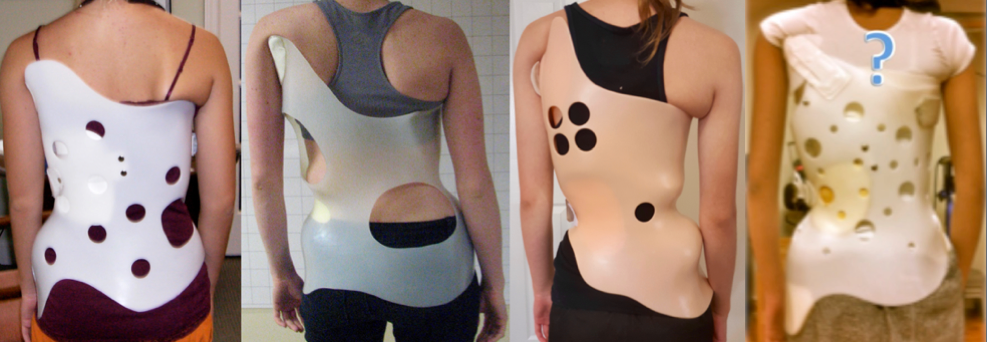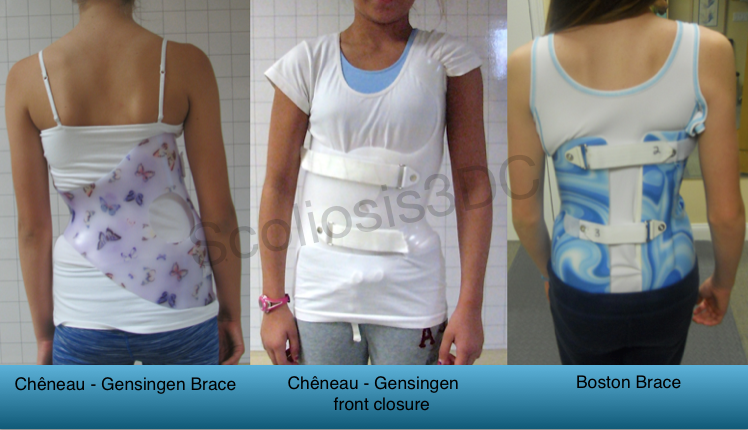“The Boston Brace made it so that she couldn’t sleep at night, she couldn’t eat or keep food down. She was losing weight and was very unhappy and scared. At Scoliosis 3DC®, it was the complete opposite.”
J. L., Boston (November 2015)
Do you think a scoliosis brace should do more than just halt progression? Is your child having trouble with the Boston Brace? Would you like your child to have the potential to improve scoliosis?
Bracing is the foundation of conservative treatment for adolescents with progressive scoliosis. While each case of adolescent idiopathic scoliosis (AIS) is different, if your child’s curvature is over 20 – 25º and (s)he still has growth potential, bracing is usually the most prudent path.
However, when it comes to scoliosis bracing, some of the concepts in use today–even by the best hospitals and facilities–are dated. The medical establishment’s stated goal for bracing scoliosis is halted progression. In the paper, A History of Bracing for Idiopathic Scoliosis in North America, the authors state, “The goals of brace treatment for AIS are to prevent progression of deformity and to obviate the need for spinal fusion, not to improve the deformity1.”
In our opinion, those goals are simply not ambitious enough for kids who require bracing. It’s one of the main reasons why we introduced the Gensingen Brace® in North America.
Like the Boston Brace, the Gensingen is rigid, although it’s made from a more forgiving and lighter weight material. Otherwise, the Gensingen Brace® differs significantly from the Boston Brace. While both aim to halt a progressive scoliosis, with the Gensingen that’s the minimum–not the primary goal. It is anasymmetric, over-corrective 3D brace, so its main advantage is to offer the potential to improve scoliosis bu reducing Cobb angle(s) and improving posture2.
The Gensingen brace is more wearable than the Boston Brace as well. That’s according to the many kids who have switched. Each Gensingen is custom-designed to the individual patient and curve-pattern-specific according to Schroth method principles. Voids, or strategically placed openings, allow for easier breathing–Schroth rotational breathing–which helps de-rotate spinal vertebrae.
In-brace corrections are consistently in the 30 – 50% range, with some patients attaining even better in-brace corrections depending on individual spinal flexibility. The potential to improve Cobb angle and create a better posture with improved wearability is a big win for scoliosis patients. An essential element of effective bracing is comfort. Easier wearability usually leads to improved compliance, and less complaining! Since it’s been determined that amount of time in a brace factors into outcome (other factors will play a role as well), the importance of wearability can’t be overstated.
Each brace is designed from a 3D scan (no radiation) making brace measuring easy. Casting, although rarely used to create braces today, is eliminated due to CAD/CAM design. The importance of CAD/CAM standardization cannot be emphasized enough. Being able to eliminate casting means a less stressful and less invasive patient experience. Standardization offers improved accuracy in manufacture and fit. On the other hand, lack of standardization, a problem for some other Chêneau-style braces leads to varied results. It’s one reason why some Rigo Chêneau braces share the same name but look and fit very differently (see photo below) depending on the person who makes and fits the brace. For more on this topic, read our blog entitled, Not All Chêneau Braces Are Created Equal.

Let’s face it, no child wants to wear a brace and no brace is ‘easy’ to wear. However, what’s important to know is that bracing has now improved beyond the limitations of compressive bracing–essentially a hard plastic shell that squeezes a child’s torso. Moreover, many of these braces are still manufactured to fasten in back. This alone can make it frustrating and difficult when it’s time for a child to put their brace on and take it off.

We can confidently state that the Gensingen brace® is the best scoliosis brace available. This bold statement is based on the results we’ve seen patients achieve in Germany, in our own facility for the past several years, and by our colleagues in Europe and Asia. This statement has also been validated by patients who have worn various other scoliosis braces and switched to the Gensingen brace® for the potential to improve a previously progressive scoliosis.
If your child is having a difficult time wearing his/her Boston brace, struggling or progressing in a nighttime brace, or has another brace that you think could be improved upon please call us to find out more about the potential of the Gensingen Brace® for your child. Our goal is to improve the scoliosis experience for each of our patients. A better brace may just be the starting point in terms of mood, attitude, comfort and most importantly outcome!
Managing scoliosis is an art as well as science. Applying the most up-to-date innovations is essential.
“She is tolerating the [Gensingen] brace she got in Boston much better than she ever tolerated the Boston brace. :)”
H.M., Guam (August 2015)
1Fayssoux RS, Cho RH, Herman MJ. A History of Bracing for Idiopathic Scoliosis in North America. Clinical Orthopaedics and Related Research. 2010;468(3):654-664. doi:10.1007/s11999-009-0888-5.
2H R Weiss, M Moramarco (2013) Remodeling of trunk and back shape deformities in patients with scoliosis using standardized asymmetric CAD / CAM braces. Hard Tissue 2(2): 2. 14 Feb.

